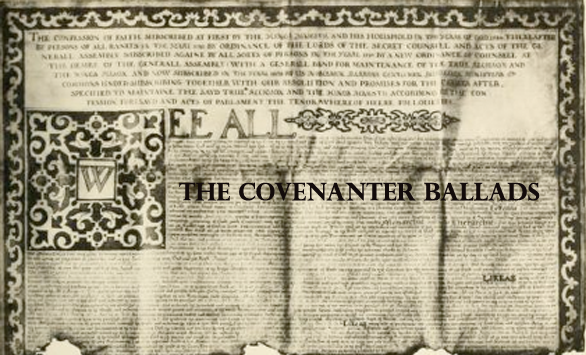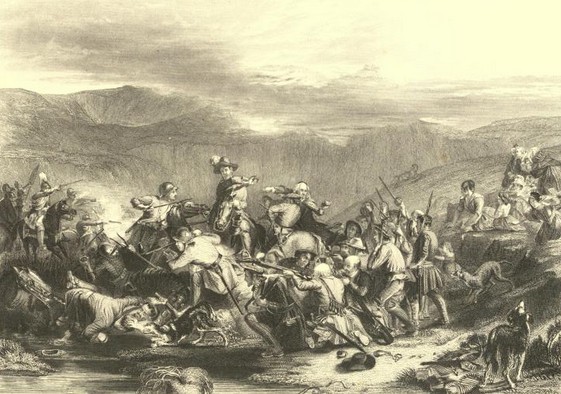The Battle of Loudon Hill
“The Battle of Loudon Hill” first appeared in 1803 edition of the Minstrelsy of the Scottish Border, when it was published in volume III. It is one of the Covenanting ballads which Scott includes and he allows it an extensive prefatory note. It presents some of the events of the skirmish as both The Battle of Drumclog and The Battle of Loudon Hill.
History
This military engagement is also known as the Battle of Drumclog, and was one of the decisive incidents of “The Killing Times”. However, given the numbers of combatants involved, it was more of a skirmish than an all-out battle.
After the murder of Archbishop Sharpe, who was loathed by the Covenanters, the entire Covenanting cause was poised for open rebellion.
Sharpe had been instrumental in introducing an Act which permitted the on-the-spot killing of anyone who was armed and who was going to, attending or returning from a field meeting of conventicle. However, on the 3rd of May 1679, a group of Covenanters, who had been lying in wait for an anti-Covenanting magistrate called William Carmichael, who had not appeared, was informed that the Archbishop was in the vicinity. They rode and intercepted the Archbishop’s coach, which he was sharing with his eldest daughter. They demanded that he got out, he refused, and they set about him inside the coach, dragged him out and hacked and shot him to death – witnessed by the surgeons who examined his body.
The murder of Sharpe was seen as an outrageous act, which required swift retribution, and the King’s forces, led by John Graham of Claverhouse, were soon scouring the country for the perpetrators.
The 29th of May, 1679, had been declared the day to celebrate the Restoration of King Charles II. In towns all over Scotland celebratory bonfires had been built and lit. However, the celebrations in Rutherglen were destined to be interrupted. On that day, a group of some 70-80 Covenanters, including Sir Robert Hamilton, James Balfour and James Russel (two of Sharp’s murderers and well-known militants) rode into Rutherglen. It is said that they extinguished the celebratory bonfire and openly declared themselves enemies of the King. At the town cross, the Reverend Thomas Douglas prayed and addressed the crowd, and the Covenanting General, Robert Hamilton produced a Declaration condemning the actions of the King’s government since 1660 and setting out their own beliefs. They then lit their own fire and burned the Acts of Parliament and those of the Privy Council. This in itself was an act of treason.
John Graham of Claverhouse, 1st Viscount of Dundee was informed of the Rutherglen Declaration and, being near Falkirk, set off to intercept this group and destroy the insurgency before it gained any more strength, probably knowing that some of Sharp’s assassins were likely to be there. News of an impending field conventicle was also relayed to Claverhouse and it seems that he determined to locate and destroy those who were attending. It was said that the conventicle was a large meeting, and it may be that Dundee realised that it would be an easier target than a group of mounted men, who may or may not have been still riding as one band.
Drumclog lies near Loudon Hill, which was the site of two battles in the Wars of Independence. It is not, and was not, easy ground to traverse, especially with mounted troops. There was a ditch between those at the Conventicle and Claverhouse troops. The Covenanters held their conventicle on a hillside, giving them a strategic advantage; and part of the land, called Coldwakning Moss, was boggy.
Although it may appear that Claverhouse’s troops should have had the advantage, this was not the case. Just as Claverhouse had his spies, so did the Covenanters, and they were aware of the government troops’ approach. Upon a signal being given, the minister – the same Thomas Douglas who had preached at Rutherglen – halted the sermon and led off the women, the children and the older men, leaving a determined band of around 250 armed Covenanters to face Claverhouse’s troops. The commander in chief was Robert Hamilton; James Balfour of Kinloch, known as Burly, led the small mounted contingent; and William Cleland seems to have led the foot soldiers. Only Balfour, however, is named in the ballad.
After an unsuccessful attempt to parley, Claverhouse’s troops fired upon the Covenanting troop and tried to advance, but the terrain was against them. Despite being outnumbered, the government troops were better equipped, but that proved useless with their cavalry bogged down. They were assaulted by the small number of mounted Covenanters and also by the infantrymen – most of whom were armed with makeshift implements. These, however, proved brutally effective. Claverhouse himself was almost taken, and had he been, he would have no doubt suffered a similar fate to Sharp. Instead, he either made his escape, on his horse , or was carried off the field by his horribily wounded horse which bolted in panic: according to several sources, the animal had been near gutted, and so, says Scott “trailed his bowels for more than a mile” (MSB (1803) III: 201). This information probably came from Dundee's Memois, who recounted “With a pitchfork they made such an opening in my sorre [sorrel] horses belly that his guts hung out half an elle and yet he caryed me af an myl” (from John Graham of Claverhouse)
Claverhouse lost men on the field and in the flight from the site of the skirmish. His kinsman Robert Graham was killed on the field and, as Scott noted, his corpse was brutalised and disfigured, as it was believed that the body was that of Claverhouse.
It was an unexpected and highly embarrassing defeat for the Government forces, and Claverhouse in particular, who found his command removed and given instead to the Duke of Monmouth. However, the opportunity for revenge was only days away and the place was Bothwell Bridge.
A partizan account of the skirmish may be found in The Scots Worthies. To offer some balance, there is mention of the assassination of Sharp and the skimish of Drumclog in the Memoirs of the Lord Viscount Dundee.
Information regarding the site and the battle can be found
in Historic Scotland’s battlefield information and on Canmore
The Characters
Burly
John Balfour of Kinloch, known as “Burley”, was a feared and respected Covenanter leader. He was described by a servant of the Duke of Hamilton as being “a little stout man, squint-eyed, and of a most ferocious aspect”. He was present at the assassination of Archbishop Sharp, at the Declaration of Rutherglen, and led the mounted division of Covenanters at Drumclog / Loudon Hill.
You can read more about him online, on the Oxford Dictionary of National Biography site. You can access this site via many public libraries and also via academic institutions.
Claverhouse
John Graham, Viscount Dundee (c.1648-27/7/1689)
John Graham, Viscount Dundee was known as “Bluidy Clavers” by his Covenanting enemies and “Bonnie Dundee” by his supporters. He himself was a staunch supporter of the royalist cause, although he did not let religious causes interfere with other aspects of his life: he married Jean Cochrane of a staunchly covenanting family. The defeat at Drumclog resulted in him losing overall command of the King’s forces in Scotland, although he played an important part at Bothwell Bridge.
He led the royalist troops at Killiecrankie and while the royalists won the day, Dundee was shot and died of his wound later in the day. He is buried in St bride’s Kirk near Blair Castle.
The Cornet
A Cornet was a military rank until 1871, when it was abolished by the British Army. It was the lowest grade of commissioned officer in a cavalry troop, after captain and lieutenant.
This was believed to have been Robert Graham, although this was a matterof some debate with 19th century historians. An explantion regarding the debate may be found in John Graham of Claverhouse, Discount Dundee
____________________
Image of Drumclog from Wylie, JA, The Scots Worthies (London: W. McKenzie, c. 1875) vol. II: insert between 476 & 477

